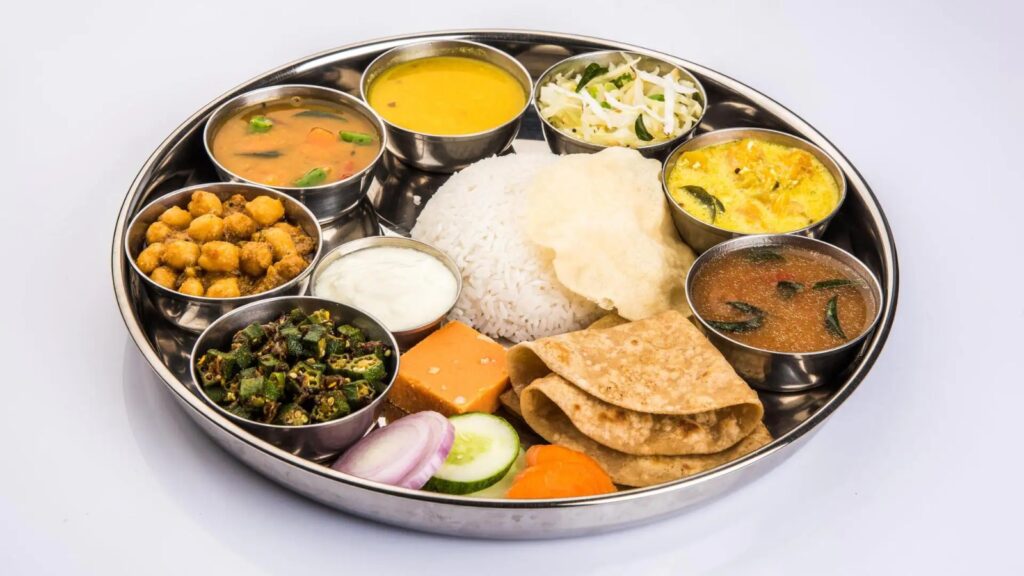Why the Cost of a Vegetarian Thali Has Risen While Chicken Has Become Cheaper, Reveals Report

The average cost of a vegetarian thali increased by 9% in May 2024 compared to the previous year, reaching Rs 27.8. Meanwhile, the cost of a non-vegetarian thali dropped by 7% to Rs 55.9.
8 June 2024
By Ishika Kumar
In a surprising economic twist, the cost of a vegetarian thali in India has surged while non-vegetarian thali, primarily chicken-based, has become more affordable.
According to the “Roti Rice Rate” report by CRISIL Market Intelligence and Analysis, the average cost of a vegetarian thali increased by 9% in May 2024 compared to the previous year, reaching Rs 27.8. Meanwhile, the cost of a non-vegetarian thali dropped by 7% to Rs 55.9. Take note of the factors driving these changes and their implications for the Indian consumer.
The Inflated Cost of Vegetarian Thalis
The vegetarian thali, a staple meal in many Indian households, typically includes roti, vegetables (onions, tomatoes and potatoes), rice, dal, curd and salad. The increase in its cost is primarily due to a significant rise in vegetable prices. The report highlights that the prices of tomatoes, potatoes and onions have soared by 39%, 41% and 43% respectively, year-on-year. This sharp rise is attributed to multiple factors:
1. Lower Crop Yields: There has been a notable decrease in the production of key vegetables. The Ministry of Agriculture and Farmers Welfare has predicted a substantial drop in onion production, from 302.08 lakh tonnes last year to 242.12 lakh tonnes in 2023-24. This 60-lakh tonne reduction is largely due to a significant drop in rabi acreage and adverse weather conditions.
2. Late Blight Disease: Late blight, a fungal disease affecting potatoes, has further compounded the problem. The disease, which damages crops if not managed properly, has led to decreased potato yields, particularly in West Bengal.
3. Water Reservoir Levels: Insufficient water levels have also impacted the production of pulses and rice, essential components of a vegetarian thali. The CRISIL report notes a 13% increase in rice prices and a 21% rise in the cost of pulses, due to lower acreage and production issues linked to water scarcity.
4. The Stabilising Factors: Despite these increases, the overall rise in the cost of a vegetarian thali has been moderated by the fall in prices of some other ingredients. Cumin, chilli and vegetable oil prices have dropped by 37%, 2% and 8% respectively, providing some relief to consumers.
The Decline of Cost in Non-Vegetarian Thali
In contrast, the cost of a non-vegetarian thali, which includes chicken instead of dal, has decreased. This drop is mainly due to a 16% reduction in broiler prices over the past year. Broilers account for approximately 50% of the cost of a non-vegetarian thali. The high base effect from last year and improved production efficiencies have contributed to this price decline.
Monthly Variations and Regional Impact
Monthly, the cost increases for a vegetarian thali have been more modest. In May 2024, the price rose marginally by 1% from April, which was Rs 27.4. For the non-vegetarian thali, the monthly cost in May 2024 was down by 1% from April’s Rs 56.3.
The average cost of preparing a thali at home is calculated based on input prices across various regions of India, reflecting the regional variations in food costs. This data shows the broader impact on household budgets, illustrating the strain on middle-class families facing rising food costs amid persistent inflationary pressures.
Economic Context
Food inflation has remained high, exceeding 8% for six consecutive months. This persistent inflation is largely driven by the increased cost of essential food items, aggravated by ongoing heat waves affecting crop yields. The Consumer Pricing Index (CPI), which heavily weights food prices, reflects this trend with food inflation contributing significantly to overall inflation.
The CRISIL report stresses the importance of the upcoming monsoon season. Well-distributed and timely rains could potentially alleviate some of the pressures on food prices. However, the uncertainty surrounding weather patterns and their impact on crop production remains a concern.
Implications for Consumers
For the average Indian consumer, these changes translate to higher daily expenses for a vegetarian diet. Middle-class households are feeling the pinch as they navigate these increased costs. Conversely, the decrease in chicken prices has made non-vegetarian meals slightly more affordable, providing some respite for those who consume meat.
The contrasting trends in the costs reflect economic dynamics and the specific challenges facing Indian agriculture. As India looks forward to the monsoon season, the hope is that favourable weather will help stabilise food prices and ease the burden on households across the country.











